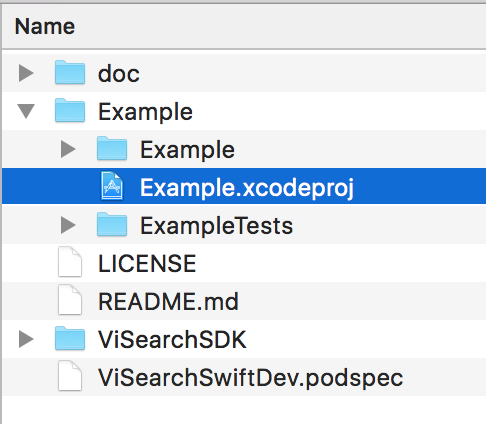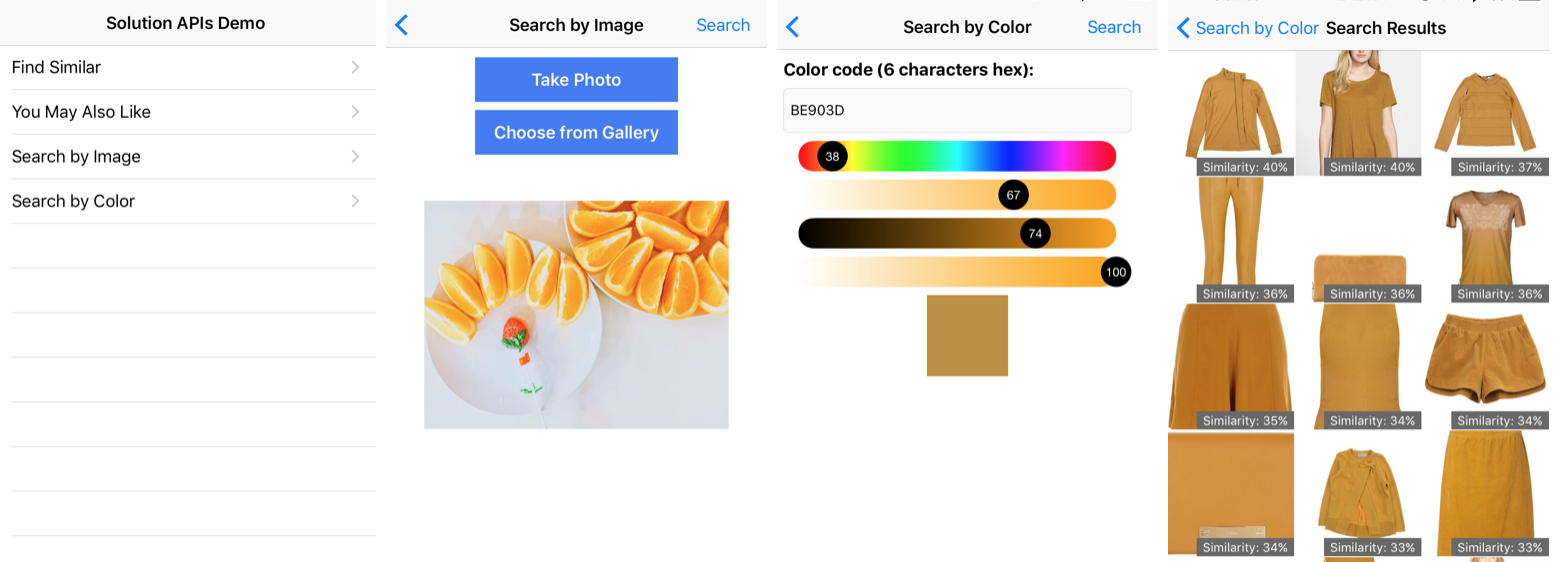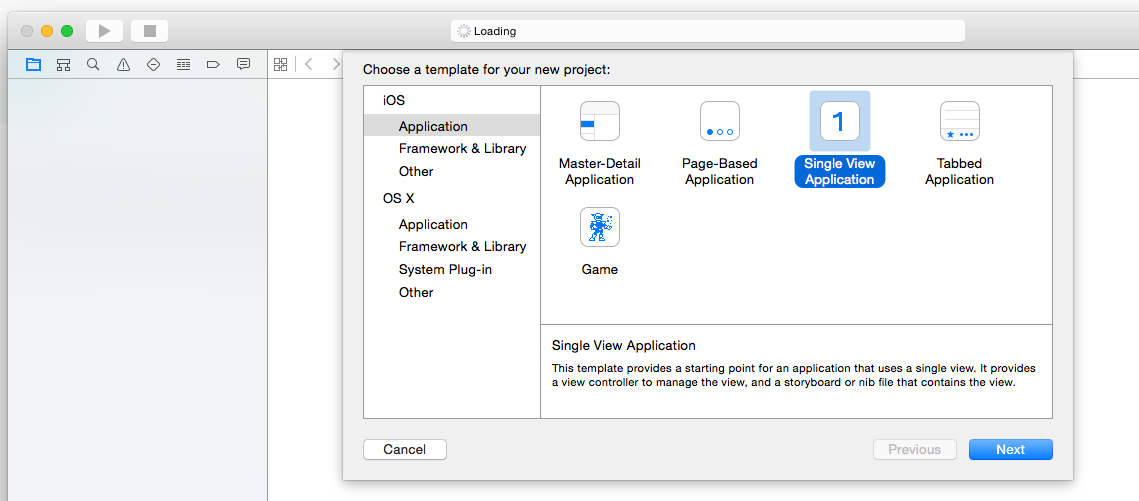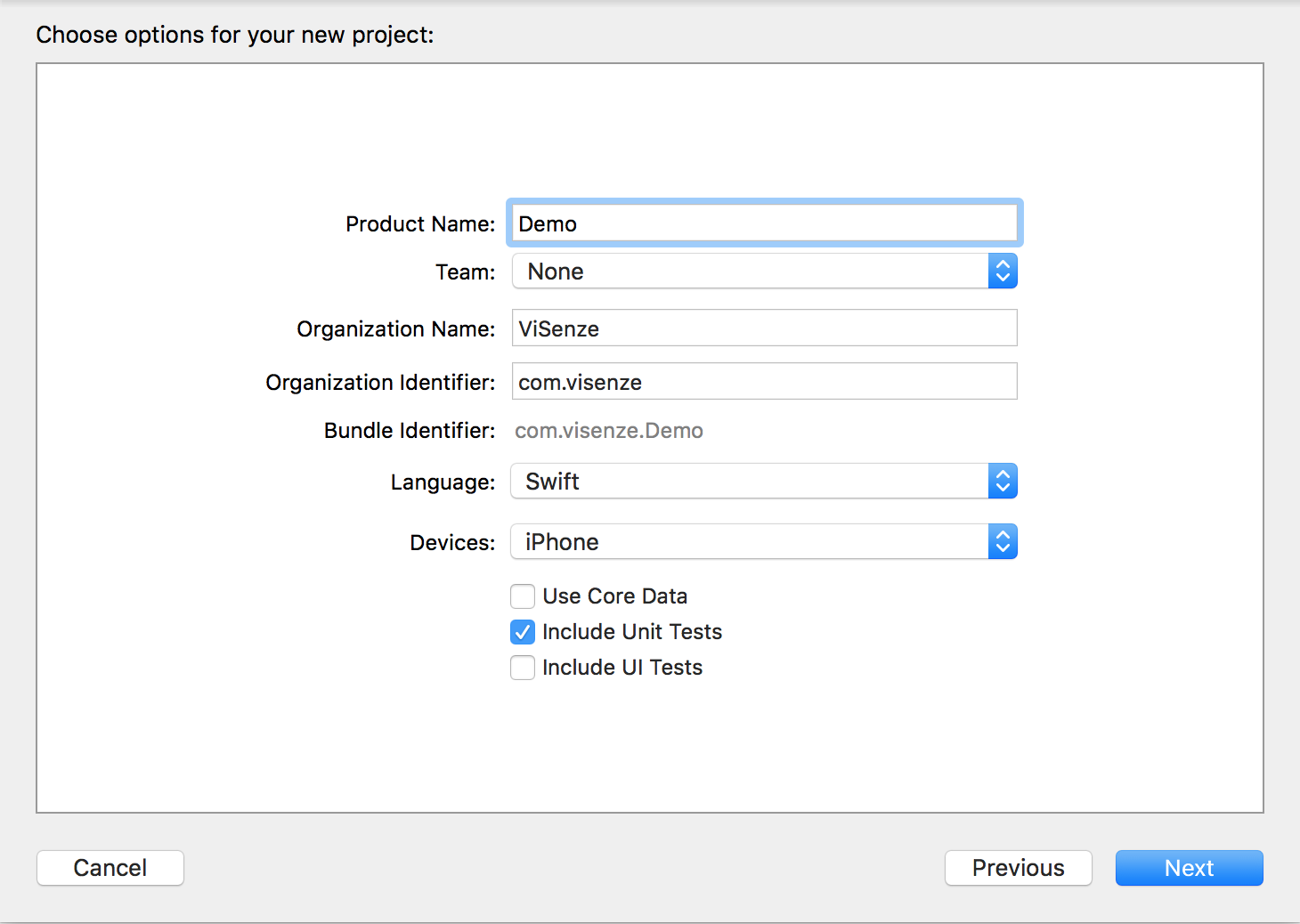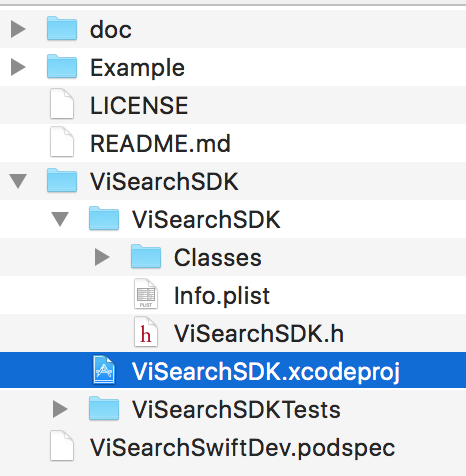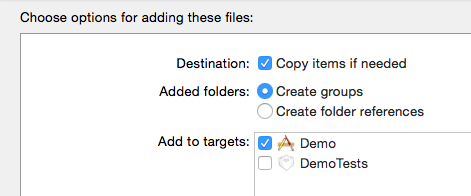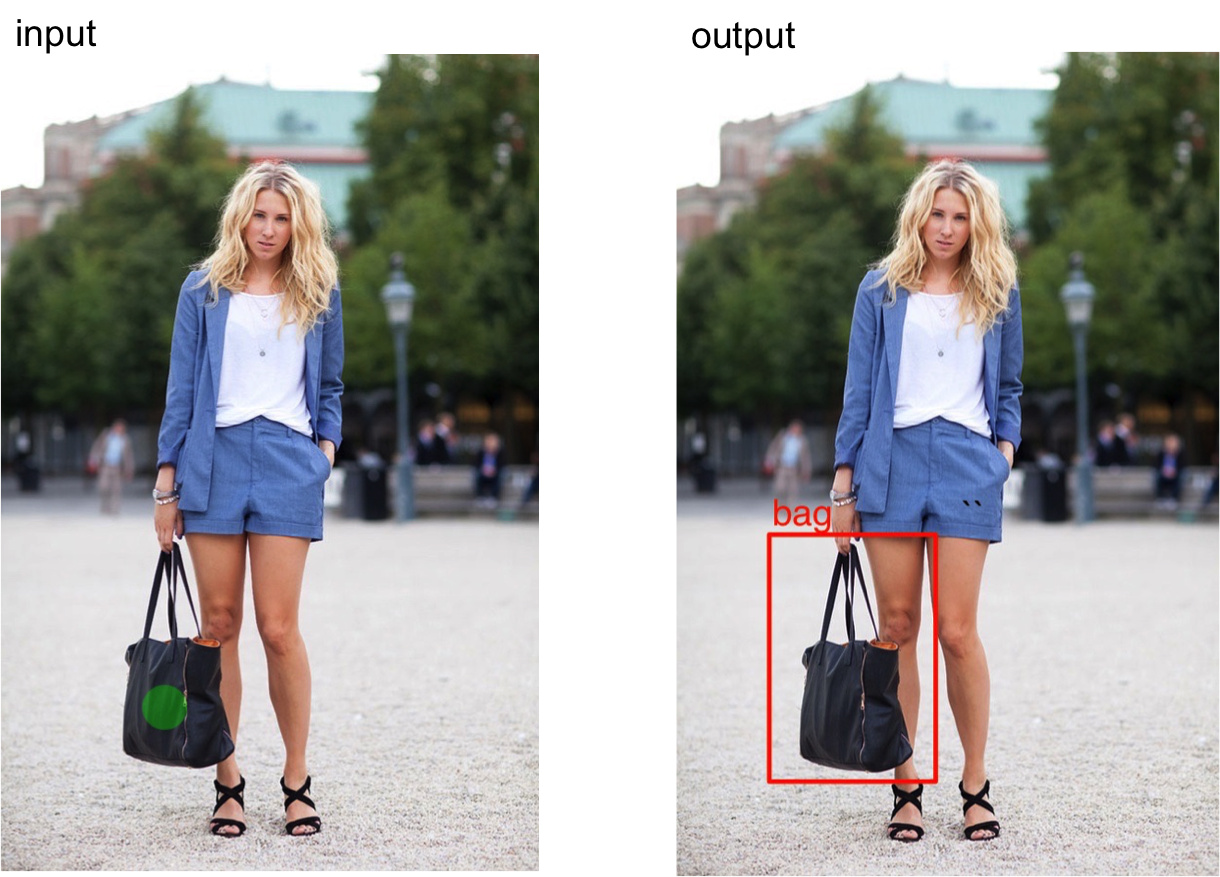ViSearchSwiftDev 0.2
| TestsTested | ✓ |
| LangLanguage | SwiftSwift |
| License | MIT |
| ReleasedLast Release | Oct 2016 |
| SPMSupports SPM | ✗ |
Maintained by Ngo Hung.
ViSearchSwiftDev 0.2
- By
- Ngo Hung
ViSearch Swift SDK and Demo Source Code
Table of Contents
- Overview
- Setup
- Initialization
- Solutions
- 4.1 Find Similar
- 4.2 You May Also Like
- 4.3 Search by Image
- 4.3.1 Selection Box
- 4.3.2 Resizing Settings
- 4.4 Search by Color
- Search Results
- Advanced Search Parameters
- Event Tracking
1. Overview
ViSearch is an API that provides accurate, reliable and scalable image search. ViSearch API provides two services (Data API and Search API) to let the developers prepare image database and perform image searches efficiently. ViSearch API can be easily integrated into your web and mobile applications. For more details, see ViSearch API Documentation.
The ViSearch iOS SDK is an open source software to provide easy integration of ViSearch Search API with your iOS applications. It provides four search methods based on the ViSearch Solution APIs - Find Similar, You May Also Like, Search By Image and Search By Color. For source code and references, please visit the Github Repository.
Current stable version:
Supported iOS version: iOS 8.x and higher
2. Setup
2.1 Run the Demo
The source code of a demo application is provided together with the SDK (demo). You can simply open Example project in XCode and run the demo.
You should change the access key and secret key in AppDelegate file to your own key pair before running.
ViSearch.sharedInstance.setup(accessKey: "YOUR_ACCESS_KEY", secret: "YOUR_SECRET_KEY")
You can play around with our demo app to see how we build up the cool image search feature using ViSearch SDK.
2.2 Set up Xcode project
In Xcode, go to File > New > Project Select the Single View Application.
Type a name for your project and press Next, here we use Demo as the project name.
2.3 Import ViSearch Swift SDK
2.3.2 Using Manual Approach
You can also download the iOS ViSearch SDK directly. To use it, unzip it and drag ViSearchSDK project into Demo project.
-
Open the
ViSearchSDKfolder, and drag theViSearchSDK.xcodeprojinto the Project Navigator of your application’s Xcode project.It should appear nested underneath your application’s blue project icon. Whether it is above or below all the other Xcode groups does not matter.
Select the
ViSearchSDK.xcodeprojin the Project Navigator and verify the deployment target matches that of your application target.- Next, select your application project in the Project Navigator (blue project icon) to navigate to the target configuration window and select the application target under the “Targets” heading in the sidebar.
- In the tab bar at the top of that window, open the “General” panel.
- Click on the
+button under the “Embedded Binaries” section. - Select the
ViSearchSDK.framework.
The
ViSearchSDK.frameworkis automagically added as a target dependency, linked framework and embedded framework.
You are done!
2.4 Add Privacy Usage Description
iOS 10 now requires user permission to access camera and photo library. If your app requires these access, please add description for NSCameraUsageDescription, NSPhotoLibraryUsageDescription in the Info.plist. More details can be found here.
3. Initialization
ViSearch must be initialized with an accessKey/secretKey pair before it can be used.
import ViSearchSDK
...
// using default ViSearch client. The client, by default, will connect to Visenze's server
ViSearch.sharedInstance.setup(accessKey: "YOUR_ACCESS_KEY", secret: "YOUR_SECRET_KEY")
...
// or using customized client, which connects to your own server
client = ViSearchClient(baseUrl: yourUrl, accessKey: accessKey, secret: secret)
...4. Solutions
4.1 Find Similar
Find similar solution is used to search for visually similar images in the image database giving an indexed image’s unique identifier (im_name).
import ViSearchSDK
...
let params = ViSearchParams(imName: "imName-example")
ViSearch.sharedInstance.findSimilar( params: params!,
successHandler: {
(data : ViResponseData?) -> Void in
// Do something when request succeeds
// preview by calling : dump(data)
// check ViResponseData.hasError and ViResponseData.error for any errors return by ViSenze server
},
failureHandler: {
(err) -> Void in
// Do something when request fails e.g. due to network error
print ("error: \\(err.localizedDescription)")
})
...4.2 You May Also Like
You may also like solution is used to provide a list of recommended items from the indexed image database based on customizable rules giving an indexed image’s unique identifier (im_name).
import ViSearchSDK
...
let params = ViSearchParams(imName: "imName-example")
ViSearch.sharedInstance.recommendation( params: params!,
successHandler: {
(data : ViResponseData?) -> Void in
// Do something when request succeeds
// preview by calling : dump(data)
// check ViResponseData.hasError and ViResponseData.error for any errors return by ViSenze server
},
failureHandler: {
(err) -> Void in
// Do something when request fails e.g. due to network error
print ("error: \\(err.localizedDescription)")
})
...4.3 Search by Image
Search by image solution is used to search similar images by uploading an image or providing an image url. You should construct the UIImage object and pass it to ViUploadSearchParams to start a search.
- Using Image
import ViSearchSDK
...
let image = UIImage(named: "someImage.png")
let params = ViUploadSearchParams(image: image!)
ViSearch.sharedInstance.uploadSearch(params: params,
successHandler: {
(data : ViResponseData?) -> Void in
// Do something when request succeeds
// preview by calling : dump(data)
// check ViResponseData.hasError and ViResponseData.error for any errors return by ViSenze server
},
failureHandler: {
(err) -> Void in
// Do something when request fails e.g. due to network error
print ("error: \\(err.localizedDescription)")
})
- Alternatively, you can pass an image url directly to
ViUploadSearchParamsto start the search :
import ViSearchSDK
...
let params = ViUploadSearchParams(im_url: "http://somesite.com/sample_image.png")
ViSearch.sharedInstance.uploadSearch(params: params!,
successHandler: {
(data : ViResponseData?) -> Void in
// Do something when request succeeds
// preview by calling : dump(data)
// check ViResponseData.hasError and ViResponseData.error for any errors return by ViSenze server
},
failureHandler: {
(err) -> Void in
// Do something when request fails e.g. due to network error
print ("error: \\(err.localizedDescription)")
})
...- Once uploading an image, you will receive a im_id attribute from the Search Results. If you want to search the same image again, you can save the bandwidth by specifying the im_id in the params:
import ViSearchSDK
...
let params = ViUploadSearchParams(im_id: "im_id_example")
ViSearch.sharedInstance.uploadSearch(params: params!,
successHandler: {
(data : ViResponseData?) -> Void in
// Do something when request succeeds
// preview by calling : dump(data)
// check ViResponseData.hasError and ViResponseData.error for any errors return by ViSenze server
},
failureHandler: {
(err) -> Void in
// Do something when request fails e.g. due to network error
print ("error: \\(err.localizedDescription)")
...4.3.1 Selection Box
If the object you wish to search for takes up only a small portion of your image, or other irrelevant objects exists in the same image, chances are the search result could become inaccurate. Use the Box parameter to refine the search area of the image to improve accuracy. The box coordinated is set with respect to the original size of the uploading image. Note: the coordinate system uses pixel as unit instead of point.
// create the box to refine the area on the searching image
// ViBox(x1, y1, x2, y2) where (0,0) is the top-left corner
// of the image, (x1, y1) is the top-left corner of the box,
// and (x2, y2) is the bottom-right corner of the box.
...
let params = ViUploadSearchParams(.....)
let box = ViBox(x1: 0, y1: 0, x2: 100, y2: 100)
params!.box = box
// start searching
...4.3.2 Resizing Settings
When performing upload search, you may notice the increased search latency with increased image file size. This is due to the increased time spent in network transferring your images to the ViSearch server, and the increased time for processing larger image files in ViSearch.
To reduce upload search latency, by default the uploadSearch method makes a copy of your image file and resizes the copy to 512x512 pixels if one of the original dimensions exceed 512 pixels. This is the optimized size to lower search latency while not sacrificing search accuracy for general use cases:
// by default, the max width of the image is set to 512px, quality is 0.97
let params = ViUploadSearchParams(.....)
// or you can explicitly set a param's settings
params?.img_settings = ViImageSettings(setting: .highQualitySetting)
If your image contains fine details such as textile patterns and textures, you can use an image with larger size for search to get better search result:
// by default, the max width of the image is set to 512px, quality is 0.97
let params = ViUploadSearchParams(.....)
// set the image with high quality settings.
// Max width is 1024px, and the quality is 0.985. Note: Quality with 1.0 take hugespace
params?.img_settings = ViImageSettings(setting: .highQualitySetting)
Or, provide the customized resize settings. To make efficient use the of the memory and network bandwidth of mobile device, the maximum size is set at 1024 x 1024. Any image exceeds the limit will be resized to the limit:
//resize the image to 800 by 800 area using jpeg 0.9 quality
params?.img_settings = ViImageSettings(size: CGSize(width: 800, height: 800), quality: 0.9)
4.4 Search by Color
Search by color solution is used to search images with similar color by providing a color code. The color code should be in Hexadecimal and passed to ViColorSearchParams as a String.
import ViSearchSDK
...
let params = ViColorSearchParams(color: "ff00ff")
// alternately, you can pass UIColor object to the initializer
// let params = ViColorSearchParams(color: someUIColorObject)
client.colorSearch( params: params!,
successHandler: {
(data : ViResponseData?) -> Void in
// Do something when request succeeds
// preview by calling : dump(data)
// check ViResponseData.hasError and ViResponseData.error for any errors return by ViSenze server
},
failureHandler: {
(err) -> Void in
// Do something when request fails e.g. due to network error
print ("error: \(err.localizedDescription)")
})
...5. Search Results
After a successful search request, a list of results are passed to the callback function in the form of ViResponseData. You can use the following properties from the result to fulfill your own purpose.
| Name | Type | Description |
|---|---|---|
| hasError | Bool | true if there are errors returned by Visenze server. |
| error | [String] | return the error messages from server if there is any. |
| result | [ViImageResult] | A list of image results returned from the server. |
| reqId | String? | A request id which can be used for tracking. More details can be found in Section 7 |
| im_id | String? | An image id returned in the result which represents a image just uploaded. It can be re-used to do an upload search on the same image again. More details in Search by image |
Below are the properties of a ViImageResult .
| Name | Type | Description |
|---|---|---|
| im_name | String | the identify name of the image. |
| im_url | String? | url of the image if available e.g. when set getAllFl to true or set fl property to include im_url |
| score | Float? | A float value ranging from 0.0 to 1.0. Refer to Section 6.3 Result Score. |
| metadataDict | Dictionary | Other metadata returned from server. Refer to Section 6.1 Retrieving Metadata. |
// example
ViSearch.sharedInstance.uploadSearch( params: params!,
successHandler: {
(data : ViResponseData?) -> Void in
// Do something when request succeeds
// preview by calling : dump(data)
// check ViResponseData.hasError and ViResponseData.error for any errors return by ViSenze server
if let data = data {
// check if that there is no error
if !data.hasError {
for imgResult in data.result {
// process img result
}
}
}
},
failureHandler: {
(err) -> Void in
// Do something when request fails e.g. due to network error
print ("error: \(err.localizedDescription)")
})
You can provide pagination parameters to control the paging of the image search results by configuring the basic search parameters in ViBaseSearchParams. As the result is returned in a format of a list of images page by page, use limit to set the number of results per page, page to indicate the page number:
| Name | Type | Description |
|---|---|---|
| page | Integer | Optional parameter to specify the page of results. The first page of result is 1. Defaults to 1. |
| limit | Integer | Optional parameter to specify the result per page limit. Defaults to 10. |
// For example, when the server side has 60 items, the search operation will return
// the first 30 items with page = 1 and limit = 30. By changing the page to 2,
// the search will return the last 30 items.
...
params.page = 2;
params.limit = 30;
// start searching
...6. Advanced Search Parameters
6.1 Retrieving Metadata
To retrieve metadata of your search results, provide a list of metadata keys as the fl (field list) in the basic search property:
params!.fl = ["price","brand","im_url"]To retrieve all metadata of your image results, specify get_all_fl parameter and set it to true:
params.getAllFl = true;In result callback you can read the metadata:
successHandler: {
(data : ViResponseData?) -> Void in
// Do something when request succeeds
// preview by calling : dump(data)
// check ViResponseData.hasError and ViResponseData.error for any errors return by ViSenze server
if let data = data {
// check if that there is no error
if !data.hasError {
for imgResult in data.result {
// process img result
// example: extract price meta-data if available in server
print imgResult.metadataDict["price"]
}
}
}
}
Only metadata of type string, int, and float can be retrieved from ViSearch. Metadata of type text is not available for retrieval.
6.2 Filtering Results
To filter search results based on metadata values, provide a map of metadata key to filter value as the fq (filter query) property:
...
// the type of "count" on db schema is int,
// so we can specify the value range, or do a value match
params?.fq["count"] = "0, 199"
params?.fq["count"] = "199"
// the type of "price" on db schema is float,
// so we can specify the value range, or do a value match
params?.fq["price"] = "0.0, 199.0"
params?.fq["price"] = "15.0"
// the type of "description" on db schema is string, so we can do a string match.
params?.fq["description"] = "wooden"
// start searching
...Querying syntax for each metadata type is listed in the following table:
| Type | FQ |
|---|---|
| string | Metadata value must be exactly matched with the query value, e.g. “Vintage Wingtips” would not match “vintage wingtips” or “vintage” |
| text | Metadata value will be indexed using full-text-search engine and supports fuzzy text matching, e.g. “A pair of high quality leather wingtips” would match any word in the phrase |
| int | Metadata value can be either:
|
| float | Metadata value can be either
|
6.3 Result Score
ViSearch image search results are ranked in descending order i.e. from the highest scores to the lowest, ranging from 1.0 to 0.0. By default, the score for each result is not returned. You can turn on the score parameter to retrieve the scores for each image result:
...
params.score = true; // result will include score for every image
// start searching
...
If you need to restrict search results from a minimum score to a maximum score, specify the score_min and/or score_max parameters:
...
params.score = true; // result will include score for every image
params.scoreMin = 0.3; // the minimum score is 0.3
params.scoreMax = 0.8; // the maximum score is 0.8
// start searching. Every image result will have a score within [0.3, 0.8].
...6.4 Automatic Object Recognition Beta
With Automatic Object Recognition, ViSearch /uploadsearch API is smart to detect the objects present in the query image and suggest the best matched product type to run the search on.
You can turn on the feature in upload search by setting the API parameter “detection=all”. We are now able to detect various types of fashion items, including Top, Dress, Bottom, Shoe, Bag, Watch and Indian Ethnic Wear. The list is ever-expanding as we explore this feature for other categories.
Notice: This feature is currently available for fashion application type only. You will need to make sure your app type is configurated as “fashion” on ViSenze dashboard.
params.detection = "all";You can use the Box parameter to restrict the image area [x1, y1, x2, y2] as the portion of your image to search for. When you input a box with 0 width and 0 height, eg. “box”:[574,224,574,224]. We will treat it as a point and detect the object over the current point.
You could also recognize objects from a paticular type on the uploaded query image through configuring the detection parameter to a specific product type as “detection={type}”. Our API will run the search within that product type.
Sample request to detect bag in an uploaded image:
params.detection = "bag";The detected product types are listed in product_types together with the match score and box area of the detected object. Multiple objects can be detected from the query image and they are ranked from the highest score to lowest. The full list of supported product types by our API will also be returned in product_types_list.
7. Event Tracking
Send Action For Tracking
User action (e.g. click on an image after search) can be sent in this way:
let params = ViTrackParams(accessKey: ViSearch.sharedInstance.client!.accessKey, reqId: recentReqId, action: "click" )
// You can also append an im_name field
params.imName = "example_clicked_im_name"
// send tracking request to server
ViSearch.sharedInstance.track(params: params!, handler: nil)
The following fields could be used for tracking user events:
| Field | Description | Required |
|---|---|---|
| reqid | visearch request id of current search. This attribute can be accessed in ViResponseData in Section 5 | Require |
| action | action type, eg: view, click, buy, add_cart. Currently, we only support click event. More events will be supported in the future. | Require |
| imName | image id (im_name) for this behavior | Optional |
